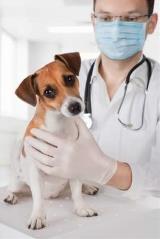Rabies Virus: Keeping Staff and Clients Informed

September 6, 2016
Rabies is one of the oldest and deadliest of zoonotic diseases. The following information will help to educate staff and clients on how to control and avoid its transmission.
Transmission of Rabies
- Bite of an infected animal
- Contact with infectious bodily fluids, such as saliva or brain tissue, that gets directly into eyes, nose, mouth, or a wound
- Non-bite exposures that occur such as scratches, abrasions, open wounds, or contact with contaminated mucous membranes
- Wear gloves when handling and/or cleaning any bite wounds
- Thoroughly wash any wounds and exposed areas with soap and water for at least five minutes
- Quarantine animal as specified by state law
- An animal that bites a person or another animal should be regarded as potentially having rabies and safety precautions should be followed
- Quarantine animal as specified by state law
- Thoroughly wash any wounds and exposed areas with soap and water for at least five minutes
- Immediately seek medical attention
- Notify local health department as soon as possible following exposure
- In the United States, the PEP consists of one dose of immune globulin and five doses of rabies vaccine over a 28-day period, given in the arm
- When PEP is given promptly and properly after exposure, no one has ever developed rabies
- Rabies is a disease that is 100% preventable and owners have a responsibility to vaccinate their pets.
- The majority of rabies infections occur in wildlife, but the greatest exposure of the disease for humans comes from their contact with domestic animals.
- Companion pets that come into contact with infected animals increase the disease transmission risk to humans, but proper vaccination of pets reduces this risk.
- Preventative pre-exposure vaccinations are available for high-risk groups such as veterinarians, technicians, animal control officers, shelter workers, and wildlife control officers.
- Blood, feces, and urine are not infectious as they do not carry the virus.
- Spaying and neutering pets will reduce the chance of exposure to rabies as it curbs the tendency to roam and fight.
- Avoid contact with wildlife, and if a wild animal is seen acting strangely, contact animal control officers.
- Clients who travel with pets should take along proof of their animal’s rabies inoculation. Owners who cannot show proof of vaccination may be fined and have their pets impounded.
- Any dog or cat that has frequent contact with humans should be vaccinated.
Rabies is a 100% preventable disease. Educating staff and clients of the basic procedures to follow when the virus is suspected, and of the importance in vaccinating their pets, will help to keep it that way.
Careers
Are you looking for a place to let your talents shine? At Covetrus, we help our practitioner customers better serve their patients and take pride in providing the best customer experience possible. Search our open positions to see our available opportunities.
Newsletter
Stay current with what’s going on with Covetrus, subscribe to receive our newsletter and email communications. Subscribers will receive the latest information in practice management, sales and marketing, animal health, and more.


Leave a comment